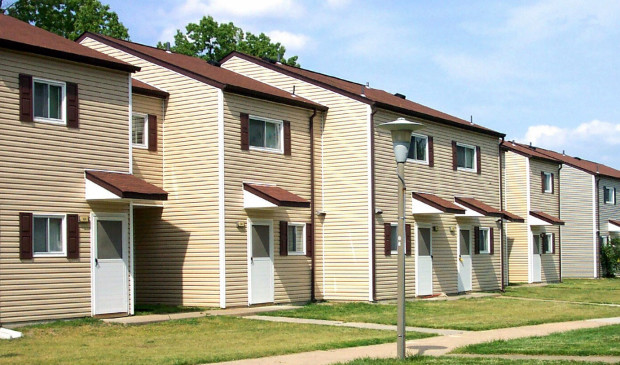Consultant outlines affordable housing study data
Wednesday, December 3, 2014 by
Tyler Whitson Affordable housing advocates and residents gathered at City Hall on Monday to weigh in on the findings and recommendations of a July report that outlines Austin’s affordable housing needs and fair choice impediments.
According to the 2014 Comprehensive Housing Market Study, the city has lost a significant amount of affordable housing since 2000, though it has been able to cushion the blow using subsidies and other approaches that it should continue to look into expanding.
The Denver firm BBC Research and Consulting conducted the study. In the study’s introduction, they noted that the city should use its findings to further the Imagine Austin comprehensive plan, which includes the CodeNEXT Land Development Code overhaul. City Council first heard the findings in July.
BBC Managing Director Heidi Aggeler told attendees that, though the city will not likely return to the affordability levels it had in 2000 — the furthest back the study goes — there are numerous strategies it can add to its “very impressive tool kit” that will help reduce costs for residents.
“The magic is making sure that that cost burden isn’t so severe that residents are foregoing basic needs and that you’re faced with a real crisis, or people are being significantly displaced from the city,” Aggeler said.
These strategies include breaking down housing choice barriers in the code’s zoning and land use policies, using publicly owned land for mixed-income development, making better use of land banking strategies, more aggressively pursuing land trusts, establishing public-private partnerships and instating an overall affordability goal for new development.
The report states that, though 55 percent of residents are renters, their incomes have not kept up with increased rent, with the median rent now $200 more per month than in 2000.
Home values have continued to increase, and now only 10 percent of homes are valued at less than $100,000.
The rental gap has also increased. In 2012, though 33 percent of rental households had incomes of less than $25,000 per year, only 10 percent of rental units were affordable to them, leaving about a 41,000-unit gap. Adjusted to 2014 rents, that number would be about 48,000.
Aggeler noted that since 2008 — when her firm conducted its last study — the total gap increase occurred almost entirely for units affordable to households making between $20,000 and $25,000 per year, while the proportion of units affordable to households making less than $20,000 per year remained about the same.
Aggeler said the gap would have increased even more had there not also been an increase in the supply of deeply subsidized housing, a development that she called “remarkable.”
The report also states that “persons with disabilities and some racial and ethnic minorities are disproportionately affected by the gap in affordability,” identifying that they are more likely to face housing discrimination and have higher poverty rates, which are 31 percent for African-American and Hispanic residents and 29 percent for those with disabilities.
It also found that publicly subsidized rental units are concentrated in a “handful” of ZIP codes, with the highest being 18 percent in 78741, which is bordered by the Colorado River and Ben White Boulevard to the north and south and U.S. 183 and Interstate 35 to the east and west. Following are 78753 with 10 percent, and 78702 and 78704 with 9 percent each.
Aggeler commented that the city should make an effort to have a greater dispersion of subsidized housing, so that there are affordable housing opportunities throughout the city.
Aggeler said her firm is exploring ways to ensure that multifamily developments that have accessible units are also affordable to people with disabilities, who face extra challenges due to the scarcity of accessible units.
One option that Aggeler referenced is prohibiting housing discrimination based on source of income, which would increase rental opportunities for people with disabilities who have Section 8 vouchers. Council has already approved an ordinance on second reading that would do this, and it is on the agenda for the next meeting Dec. 11.
Aggeler commented that state law makes guaranteeing affordable housing more difficult by not allowing inclusionary zoning — also known as inclusionary housing — which would require that developers dedicate a certain proportion of new construction as affordable housing.
HousingWorks Austin board member Frances Ferguson said publicly that Aggeler’s statement about state law is “partly correct,” but that inclusionary housing is not “totally prohibited” and asked Aggeler to clarify her statement. “In some cases,” she added, “it is actually allowed, and clearly you can allow inclusion through incentives.”
Austin has taken advantage of this through things like the Planned Unit Development Ordinance and the Downtown Density Bonus Program.
BBC conducted the study using population and household levels and projections from the city demographer, social and economic census data from between 2000 and 2012, housing market data through 2013 from the Austin Board of Realtors, rental data from Austin Investor Interests, subsidized rental unit data from the City of Austin and the Housing Authority of the City of Austin, and employment data from the Bureau of Labor Statistics and the Creative Austin report.
BBC states that it also conducted a survey this year of more than 5,000 Austin residents and more than 900 residents of nearby areas who commute to the city, assembled focus groups with 57 low-income residents, and held interviews and meetings with more than 70 stakeholders and residents.
BBC followed up its Monday presentation on Tuesday morning at the LifeWorks South Austin Youth and Family Resource Center with a presentation titled “Affordable Housing in Austin: Dig Deeper into the Data.”
You're a community leader
And we’re honored you look to us for serious, in-depth news. You know a strong community needs local and dedicated watchdog reporting. We’re here for you and that won’t change. Now will you take the powerful next step and support our nonprofit news organization?








